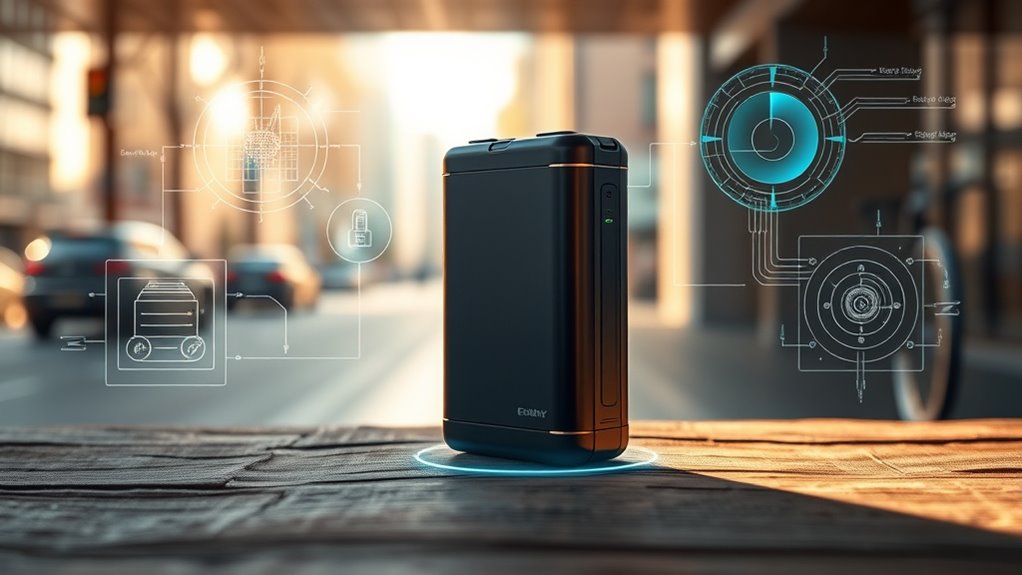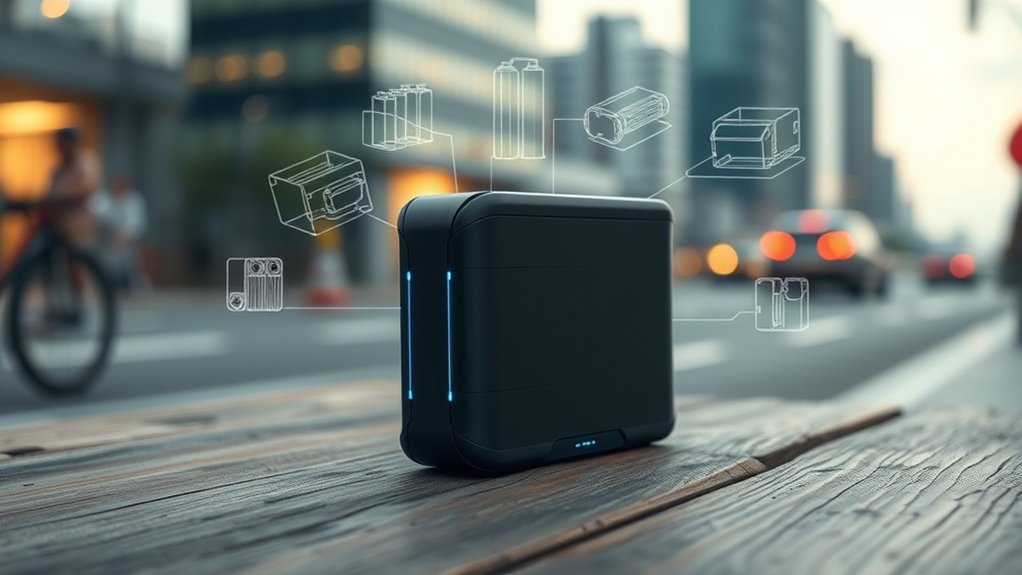The future of portable e-bike batteries is bright, with advancements like solid-state and fast-charging tech making rides longer, lighter, and more convenient. You’ll soon enjoy quicker top-ups, greater safety, and smarter batteries that optimize performance. Charging infrastructure will expand, giving you more access and confidence for extended trips. If you want to discover how these innovations will transform your rides and everyday experiences, keep exploring what’s next in battery technology.
Key Takeaways
- Future batteries will feature higher energy densities and faster charging, enabling longer rides and quicker top-ups.
- Wireless and solar-powered charging stations will increase convenience and support on-the-go recharging.
- Smarter battery management systems will optimize lifespan, safety, and performance.
- Continued innovation in solid-state and advanced chemistries will push energy storage limits further.
- Integration of charging infrastructure with IoT technology will enable seamless, real-time updates and enhanced user experiences.

The evolution of portable e-bike batteries has considerably transformed how we experience electric cycling, making it more accessible and convenient for riders. As technology advances, you’re now able to enjoy longer rides with batteries that pack more power into smaller, lighter packs. The key to these improvements lies in ongoing developments in battery chemistry. Early lithium-ion batteries have given way to newer formulations like lithium-polymer and solid-state batteries, which offer higher energy densities, faster charging times, and greater safety. These advancements mean you can go farther on a single charge and spend less time plugged in, enhancing your overall riding experience. Plus, as the chemistry improves, batteries become more durable and reliable, reducing the need for frequent replacements and giving you peace of mind on longer journeys.
Alongside battery chemistry, the charging infrastructure has seen significant growth. Modern charging stations are becoming more widespread, often integrated into urban settings, workplaces, and public spaces, making it easier for you to top up your e-bike wherever you go. Fast-charging options mean you can regain a substantial charge in just 30 minutes or less, cutting down downtime and encouraging more spontaneous rides. This improved infrastructure also addresses range anxiety, one of the main concerns for e-bike users, by providing a network of accessible charging points that seamlessly fit into your daily routine. As more cities and communities invest in charging stations, you’ll find it easier to plan longer trips, knowing that charging support is nearby.
The combination of advanced battery chemistry and expanded charging infrastructure is setting the stage for a future where electric cycling becomes even more integrated into everyday life. Imagine taking your e-bike on a weekend getaway without worrying about running out of power, thanks to faster charging and longer-lasting batteries. Furthermore, innovations like wireless charging pads and solar-powered stations are on the horizon, promising even more convenience. These developments will make your rides more spontaneous and less constrained by technical limitations. As the technology matures, expect batteries to become smarter, with built-in management systems that optimize performance and lifespan, and charging stations that communicate with your bike to provide real-time updates. Additionally, the development of more efficient battery chemistries will continue to push the boundaries of energy storage capabilities.
In essence, the future of portable e-bike batteries is bright, driven by improvements in chemistry and infrastructure that work together to make electric cycling more practical, enjoyable, and sustainable. You’ll soon benefit from lighter, more powerful batteries and a more robust network of charging options, removing barriers that once limited your riding adventures. The evolution is ongoing, and each breakthrough brings you closer to a seamless, more exhilarating e-bike experience.
Frequently Asked Questions
How Do Battery Life Cycles Compare Across Different Brands?
When comparing battery life cycles across brands, you’ll notice differences in battery durability and brand reliability. Some brands offer longer-lasting batteries with more charge cycles, meaning they stay efficient over time. Others might have a shorter lifespan but lower costs. You should look for trusted brands known for quality, as reliable batteries tend to sustain their performance longer. Overall, choosing a reputable brand can ensure better durability and more dependable performance in the long run.
What Are the Environmental Impacts of Battery Disposal?
You should consider the environmental impacts of battery disposal, especially since recycling challenges make it difficult to recover valuable materials. When you discard batteries improperly, toxic materials like heavy metals can leach into the soil and water, harming ecosystems and human health. To reduce these risks, always recycle your e-bike batteries through certified programs, ensuring harmful substances are safely managed and reused, minimizing your environmental footprint.
How Long Are Portable E-Bike Batteries Expected to Last?
Imagine your e-bike battery as a diligent worker, steadily serving you over time. On average, it offers about 3 to 5 years of battery longevity, depending on usage and care. Modern batteries improve charging efficiency, allowing quicker, more reliable power-ups. With proper maintenance, you can extend its lifespan, ensuring your trusty energy source keeps riding strong for many miles ahead.
Are There Any Current Innovations in Fast-Charging Technology?
You’ll be pleased to know that innovations like ultra fast charging are transforming e-bike batteries today. Some models now support wireless charging, making recharging more convenient and efficient. These advancements mean you can spend less time plugged in and more time riding. Manufacturers are continuously improving charging speeds, so expect even faster options soon. With wireless tech and ultra fast charging, your e-bike’s battery life and convenience are set to dramatically improve.
How Do Battery Weights Affect Overall E-Bike Performance?
Imagine you’re climbing a hill on your e-bike; your battery weight directly impacts your ride. Heavier batteries increase overall weight, which can reduce acceleration, shorten range, and make pedaling harder. Conversely, lighter batteries improve performance by decreasing the load, allowing for better speed and efficiency. So, choosing a battery with ideal weight is vital for maintaining peak e-bike performance and ensuring a smoother, more responsive ride.
Conclusion
As you ride into the future, remember that portable e-bike batteries are like seeds planted in innovation’s fertile ground—each new development promises a stronger, longer-lasting harvest. Just last year, a breakthrough doubled battery life, transforming weekend rides into seamless journeys. Like a compass guiding explorers, these advancements point toward a world where your e-bike becomes an unstoppable companion, ready to take you farther than ever before. Embrace the evolution—your next adventure is just a charge away.









